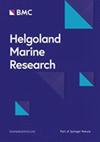对紫紫水母寄主利用模式的探索及其交配系统的推断
4区 地球科学
Q2 Agricultural and Biological Sciences
引用次数: 8
摘要
在共生甲壳类动物中,寄主利用模式差异很大。有些物种单独生活在宿主个体中,有些物种生活在异性伴侣中,甚至还有一些物种生活在群体中。这种宿主利用模式的差异加上宿主生态的巨大差异,为探索环境条件如何影响动物行为提供了机会。在这项研究中,我们探讨了共生甲壳类动物是否居住在相对较大和结构复杂的寄主物种中。考虑到上述寄主特征限制了共生甲壳类动物的寄主独占行为,我们认为生活在大型且形态复杂的水螅类水母Lychnorhiza lucerna触手之间的小壳壳虾Periclimenes paivai可能是群居的。本文描述了巴西Paraíba河河口附近的一次露色草开花期间白花假蝇的种群分布。白家鸡种群分布与随机泊松分布无统计学差异。雄性对虾以小群体(2 ~ 4只)的形式栖息在露色藻个体的表面,与预期一致。双爪鱼是一种两性异形物种,雄性的平均体型比雌性小,没有精致的武器(爪子)。雌性,而不是雄性,在螯大小上经历正异速生长,并且被发现单独生活在小而不是大的寄主个体中。上述情况表明,雌性可能是有领土意识的,或者它们可能在争夺可能影响其生殖产出的资源(即食物)。我们的研究结果与大型和形态复杂的寄主物种应该容纳非领土群居共生甲壳类动物的观点一致,但只是部分同意。共生甲壳类动物代表了很好的模型,可以提高我们对驱动海洋生物社会行为的条件的理解。本文章由计算机程序翻译,如有差异,请以英文原文为准。
Host-use pattern of the shrimp Periclimenes paivai on the scyphozoan jellyfish Lychnorhiza lucerna: probing for territoriality and inferring its mating system
In symbiotic crustaceans, host-use patterns vary broadly. Some species inhabit host individuals solitarily, other species live in heterosexual pairs, and even other species live in aggregations. This disparity in host-use patterns coupled with considerable differences in host ecology provide opportunities to explore how environmental conditions affect animal behavior. In this study, we explored whether or not symbiotic crustaceans inhabiting relatively large and structurally complex host species live in aggregations. We expected Periclimenes paivai, a small caridean shrimp that lives among the tentacles of the large and morphologically complex scyphozoan jellyfish Lychnorhiza lucerna, to live in groups given that the host traits above constraint host-monopolization behaviors by symbiotic crustaceans. We described the population distribution of P. paivai during a bloom of L. lucerna near the mouth of the Paraíba River estuary in Paraíba, Brazil. The population distribution of P. paivai did not differ statistically from a random Poisson distribution. Male shrimps were most often found dwelling on the surface of L. lucerna individuals as small groups (2–4 individuals), in agreement with expectations. Periclimenes paivai is a sexually dimorphic species with males attaining smaller average body sizes than females and exhibiting no elaborated weaponry (claws). Females, but not males, experience positive allometry in cheliped size and were found living solitarily in small but not large host individuals. The above suggest that females might be territorial or that they might be competing for resources (i.e., food) likely expected to impact their reproductive output. Our results agree, but only partially, with the idea that large and morphologically complex host species should harbor non-territorial gregarious symbiotic crustaceans. Symbiotic crustaceans represent excellent models to improve our understanding about the conditions driving the social behavior of marine organisms.
求助全文
通过发布文献求助,成功后即可免费获取论文全文。
去求助
来源期刊

Helgoland Marine Research
地学-海洋学
自引率
0.00%
发文量
0
审稿时长
6-12 weeks
期刊介绍:
Helgoland Marine Research is an open access, peer reviewed journal, publishing original research as well as reviews on all aspects of marine and brackish water ecosystems, with a focus on how organisms survive in, and interact with, their environment.
The aim of Helgoland Marine Research is to publish work with a regional focus, but with clear global implications, or vice versa; research with global emphasis and regional ramifications. We are particularly interested in contributions that further our general understanding of how marine ecosystems work, and that concentrate on species’ interactions.
 求助内容:
求助内容: 应助结果提醒方式:
应助结果提醒方式:


